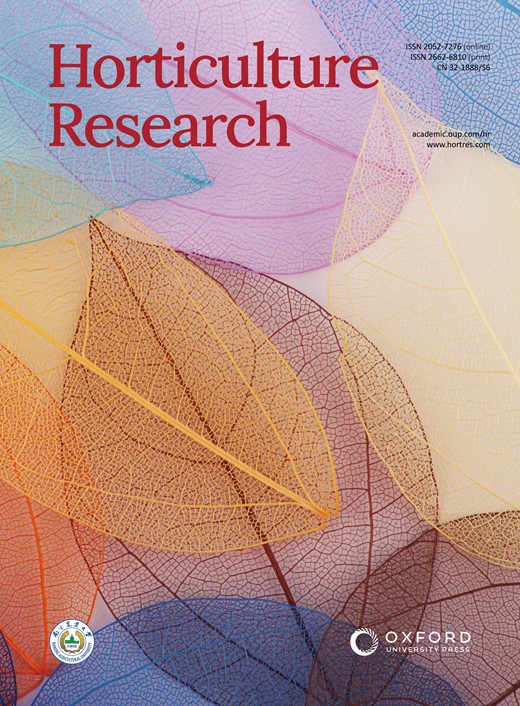一种高效、遗传的番茄病毒诱导基因组编辑系统的建立
IF 8.7
1区 农林科学
Q1 Agricultural and Biological Sciences
引用次数: 0
摘要
CRISPR-Cas9系统可用于将位点特异性突变引入番茄(Solanum lycopersicum)植物的基因组。然而,将这一革命性技术直接应用于理想的番茄品种一直受到产生转基因植物的挑战的阻碍。为了解决这一问题,我们利用烟草响尾蛇病毒(TRV)对一种优质番茄品种(Saladette父系)开发了一种高效、可遗传的基因组编辑系统。值得注意的是,一旦建立了表达cas9的番茄系,这种病毒诱导的基因组编辑(VIGE)系统可以快速生产各种突变种子,而无需额外的植物转化和组织培养。该VIGE系统由番茄泛素10 (SlUbi10)基因启动子控制表达Cas9的转基因番茄植株和利用番茄开花位点T (SlFT)基因序列生成的移动引导RNA支架(gRNA:SlmFT)组成。我们通过靶向番茄植物烯去饱和酶(SlPDS)基因来确定其编辑效率,该基因在被破坏时会引起光漂白症状。携带SlPDS靶向sgRNA的TRV载体感染的大多数转基因幼苗产生嵌合白化叶片,并伴有SlPDS基因的高频率indel突变。值得注意的是,这些植物的果实产生纯合子SlPDS敲除种子的比率在15%到100%之间。这些结果证明了我们的vinge系统在快速产生可遗传的番茄基因组编辑方面的卓越有效性。本文章由计算机程序翻译,如有差异,请以英文原文为准。
Development of an efficient and heritable virus-induced genome editing system in Solanum lycopersicum
The CRISPR-Cas9 system can be used to introduce site-specific mutations into the genome of tomato (Solanum lycopersicum) plants. However, the direct application of this revolutionary technology to desirable tomato cultivars has been hindered by the challenges of generating transgenic plants. To address this issue, we developed an efficient and heritable genome editing system using tobacco rattle virus (TRV) for an elite tomato cultivar (the paternal line of Saladette). Notably, this virus-induced genome editing (VIGE) system enables the rapid production of various mutant seeds without the need for additional plant transformation and tissue culture, once a Cas9-expressing tomato line is established. This VIGE system consists of transgenic tomato plants that express Cas9 under the control of the tomato ubiquitin 10 (SlUbi10) gene promoter and a mobile guide RNA scaffold (gRNA:SlmFT) generated using the sequence of the tomato Flowering Locus T (SlFT) gene. We determined its editing efficiency by targeting the tomato phytoene desaturase (SlPDS) gene, which causes photobleaching symptoms when disrupted. Most transgenic seedlings infected with the TRV vectors carrying the SlPDS-targeting sgRNA developed chimeric albino leaves associated with a high frequency of indel mutations in the SlPDS gene. Remarkably, fruits from these plants yielded homozygous SlPDS knockout seeds at rates ranging from 15% to 100%. These results demonstrate the exceptional effectiveness of our VIGE system in rapidly generating heritable genome edits in tomato.
求助全文
通过发布文献求助,成功后即可免费获取论文全文。
去求助
来源期刊

Horticulture Research
Biochemistry, Genetics and Molecular Biology-Biochemistry
CiteScore
11.20
自引率
6.90%
发文量
367
审稿时长
20 weeks
期刊介绍:
Horticulture Research, an open access journal affiliated with Nanjing Agricultural University, has achieved the prestigious ranking of number one in the Horticulture category of the Journal Citation Reports ™ from Clarivate, 2022. As a leading publication in the field, the journal is dedicated to disseminating original research articles, comprehensive reviews, insightful perspectives, thought-provoking comments, and valuable correspondence articles and letters to the editor. Its scope encompasses all vital aspects of horticultural plants and disciplines, such as biotechnology, breeding, cellular and molecular biology, evolution, genetics, inter-species interactions, physiology, and the origination and domestication of crops.
 求助内容:
求助内容: 应助结果提醒方式:
应助结果提醒方式:


